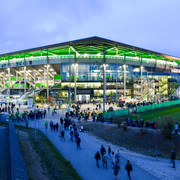The first documented mention of St. Anne’s Church is in 1302. It is one of the oldest buildings of historic importance in Wolfsburg. The small rubble and fieldstone building was once the parish church of the village of Hesslingen. Most of the church that still exists today probably dates from the second third of the 13th century, It has since been converted, destroyed and rebuilt several times. The church was renovated for the last time in the years 1959 to 1961. In 2013, the church was covered with a bright plaster to protect the masonry, giving it the graceful look it now has. The church was also repainted on the inside in 2014.
The church consists of a transverse rectangular west tower, a single nave, the broad oblong chancel and the semi-circular apse, where the stone altar is located. The tower basement was converted into a baptistery. There have always been two bells at the top of the tower: the older of the two dates from the mid-13th century (!), the younger from 1423 The only decorative figure in the church is the late Gothic sculpture of the Madonna and Child with St. Anne (from around 1520 to 1530). During the last renovation, the church was fitted with eight stained glass windows. Three artists designed them on the basis of themes specified by Pastor E. Bammel. The parapet organ was inaugurated in 1966. It comes from a Lübeck workshop and has 7 stops, one manual, one pedal and 508 pipes.
The church consists of a transverse rectangular west tower, a single nave, the broad oblong chancel and the semi-circular apse, where the stone altar is located. The tower basement was converted into a baptistery. There have always been two bells at the top of the tower: the older of the two dates from the mid-13th century (!), the younger from 1423 The only decorative figure in the church is the late Gothic sculpture of the Madonna and Child with St. Anne (from around 1520 to 1530). During the last renovation, the church was fitted with eight stained glass windows. Three artists designed them on the basis of themes specified by Pastor E. Bammel. The parapet organ was inaugurated in 1966. It comes from a Lübeck workshop and has 7 stops, one manual, one pedal and 508 pipes.
Good to know
Author
Wolfsburg Wirtschaft und Marketing GmbH
Porschestraße 26
38440 Wolfsburg
Organization
Wolfsburg Wirtschaft und Marketing GmbH
Nearby

